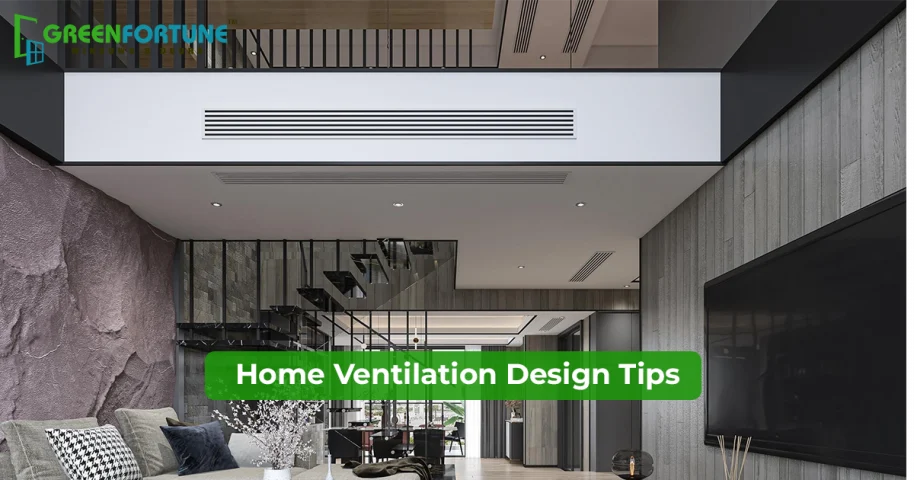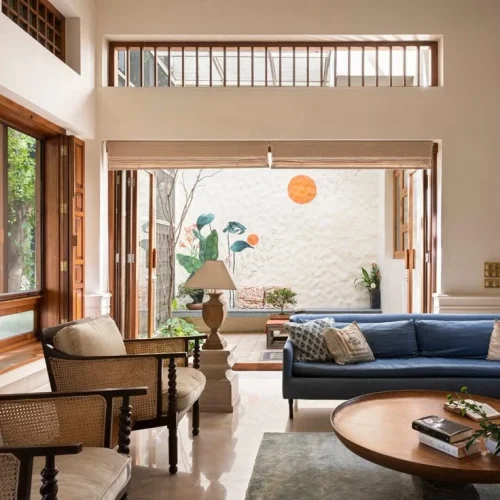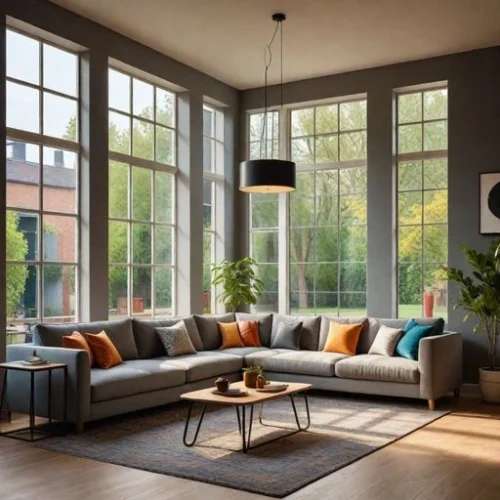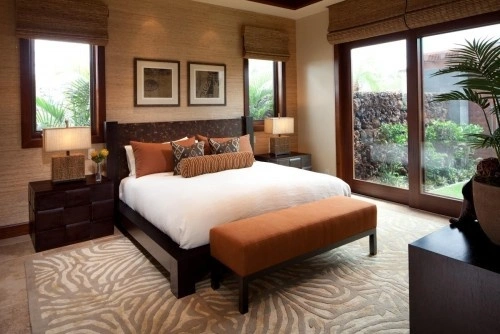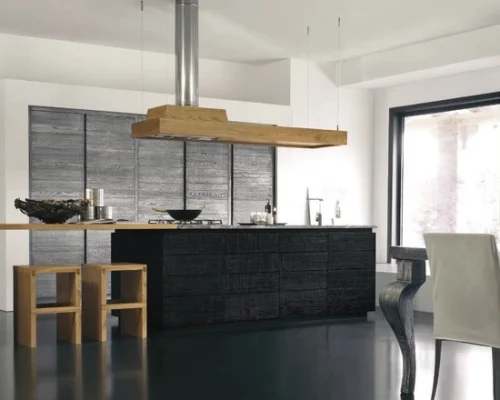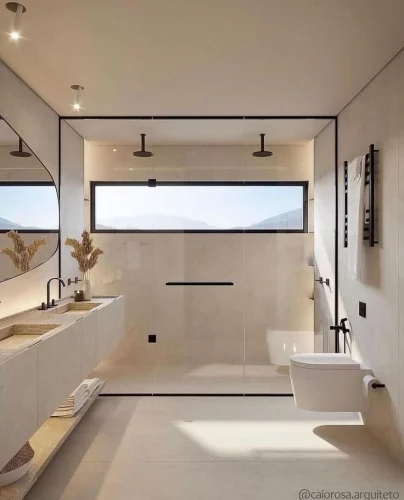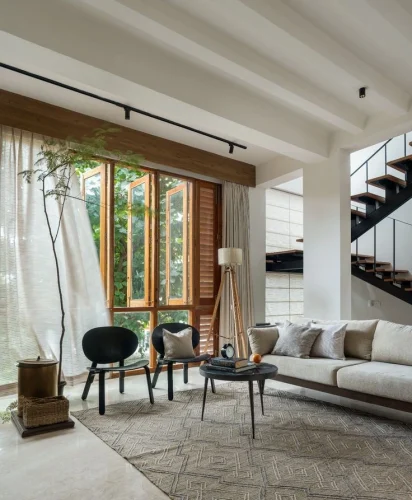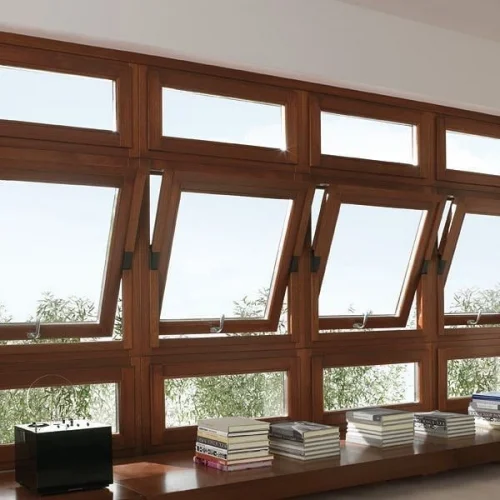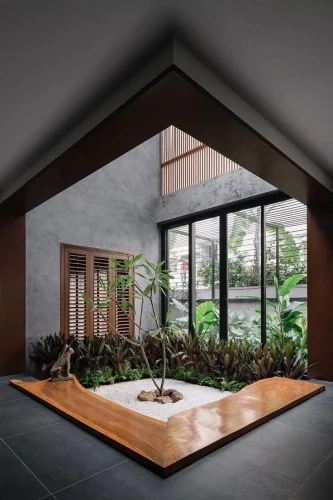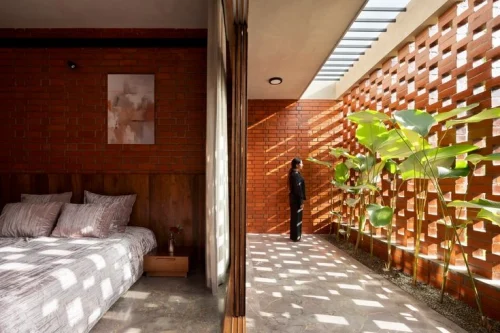
10 Curved Sofa Living Room Ideas That Instantly Lift Your Space
June 2, 2025
Work Meets Style: 5 Modern Study Table Design Ideas to Try Now
June 3, 2025This guide to home ventilation design shows you how to let fresh air in and keep heat out.
Introduction
We all want our homes to be comfortable. A soft mattress, a good sofa, warm lighting, spotless floors, and a cosy corner to read books and relax. But comfort starts with something far simpler- air.
If you walk into a home and immediately feel heavy, tired, or like something’s off… it’s not usually the paint, decor or the furniture. It’s poor air circulation.
And no, having a fan or AC won’t fix that. A fan moves the same stale air around, and the AC only cools it. What you need is for the air to move. To enter. To exit.
That’s what home ventilation design is all about.
It ensures fresh air comes in, hot air escapes, and there’s a natural path for airflow between walls, windows and doors.
And it’s more important than what you think.
Also read: How ventilation windows improve indoor air quality?
How To Design Ventilation For Your Home?
A good home ventilation design decides whether your house stays fresh or traps heat, humidity, and smells.
#1 Decide where the air should enter and exit
Stand on your plot or balcony and see where the breeze hits your face. Every location has a dominant wind direction. In many parts of India, it’s mostly the Southwest. That’s your entry point.
Now the next important thing is to find the exit point. If there’s no path to exit, like no opposite window, door, or ventilator, the air is going to just sit in the room. That’s what makes a space feel still and heavy.
This is where cross-ventilation matters.
You don’t need huge windows. Just two openings on different walls. Air enters through one, flows through the room, and exits through the other.
This single step can change how your home feels forever.
#2 Don’t use the same ventilation setup everywhere
Not every room needs the same type of ventilation.
Bedrooms
- In bedrooms, place two openable windows, one facing the breeze (often southwest or southeast), and another on the opposite or side wall. Cross ventilation benefits even when the fan is off.
- If you cannot place two windows, try one regular window and one high-level ventilator above the door or on the opposite wall.
- Avoid blocking windows with furniture or blackout curtains.
- If your bedroom gets hot in the afternoons, use louvred windows or a small skylight vent to let warm air rise and escape.
Kitchens
- In kitchens, place a window near the stove (west-facing if possible, as that’s where heat builds up most).
- Place an exhaust fan on the opposite wall or high up near the ceiling.
- Make sure not to use fully sealed glass here. Use a sliding or casement window with a mesh. This lets out hot air and smoke while pulling in a fresh breeze, so the kitchen doesn’t stay humid or sticky.
Bathrooms
If you skip proper ventilation in the bathroom, it causes permanent dampness. It will trap steam, and that smell won’t go away even with air fresheners.
- Have a small, high-level window (ideally facing outside or an open shaft) and a good exhaust fan above the toilet or shower area.
- Keep a vent gap below the bathroom door or a small louvre grill on top, as this helps air move out.
Living Rooms
- In living rooms, place windows on two opposite or diagonally opposite walls for free airflow across the room.
- If your living room faces a balcony or a garden, keep that opening wide and use sliding glass doors with mesh for cross ventilation.
- If your living room gets direct sunlight from the west, use long overhangs or external blinds to reduce heat.
- If you want your living room to feel breezy and light, have double-door or tall windows, especially southwest or northeast facing.
Also read: How sliding doors with mesh improve ventilation and comfort?
#3 Pick the right windows
Here is where many builders go wrong. They use sealed fixed glass panels for looks. But no matter how beautiful it looks, if it doesn’t open, it’s a wall. Not a window.
Choosing a window that helps with airflow is very important. Here are some options.
- Sliding windows
- Louvred windows
- Double-door or casement windows
- Windows with mesh
- Roof or loft ventilators
If you are worried about safety, just add a grill or bars. Do not compromise on ventilation. Ever.
#4 Go for passive cooling homes
Ventilation is not only about the right window placement for airflow. It’s also about temperature control.
- Use trees, creepers, or bamboo screens near windows, as they cool the breeze before it enters.
- Place courtyards, or cut-outs in central areas, as they pull hot air up like a chimney.
- Have skylights and ceiling vents to let warm air rise and escape.
- Use ventilated wood panels or false ceilings to reduce heat from the roof.
These are very simple ideas to make your home feel cooler, drier and lighter throughout the year.
A good home ventilation design doesn’t just keep you cool, it changes the entire feel of your home. The way it smells, the way you feel when you sit down to rest.
Mistakes To Avoid While Planning Ventilation
You don’t want your house to feel stuffy, right? Don’t make the following mistakes.
- Placing all the windows on one side of the house, leaving no space for crossflow.
- Having only one small window per room which is not enough for air circulation.
- No exhaust fans in wet areas.
- Using sealed windows just for “aesthetic looks”.
- Blocking airflow paths with furniture.
- Skipping ventilators for privacy.
Do You Really Need Ventilation Systems?
In Indian homes, natural ventilation + a few exhaust fans is all that you need.
Unless you are building a sealed luxury villa, the ventilation systems, like supply-only fans, balanced systems, and heat recovery ventilators (HRV/ERV), are not needed. They are mostly used in extremely cold countries or tightly sealed buildings.
Also read: Which ventilation systems are best for your home’s air quality?
Final Takeaway
We often focus on tiles, wallpapers, or furniture, but forget the one thing that’s actually very important- ventilation. With a good home ventilation design, you add proper airflow to your existing home.
Small changes like adding exhaust fans in kitchens and bathrooms, keeping the windows open daily for a few hours, replacing fixed panels with openable windows, installing ventilated uPVC windows, using mesh + bars to leave windows open at night, etc., can make your home more breathable.
GreenFortune’s uPVC windows and doors let in fresh air while keeping heat and noise out. It’s an easy fix that lasts for years.







